In This Article
✨Was this helpful? Spread the word! 🚀
Listen, I’ve been there. You walk out to your backyard oasis, ready for a refreshing swim, only to find a layer of leaves, bugs, and mystery debris floating on the surface. Not exactly the Instagram-worthy moment you were hoping for, right? That’s where a good pool surface skimmer net becomes your best friend.
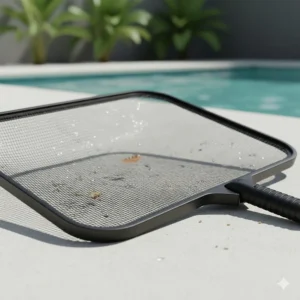
A pool surface skimmer net is essentially a specialized cleaning tool designed to remove floating debris from your pool’s surface before it sinks and becomes a real headache. Think of it as your pool’s first line of defense against dirt, leaves, pollen, and those unfortunate insects that didn’t quite make it across. Whether you’re dealing with an above-ground setup or an inground masterpiece, having the right skimmer net makes maintenance dramatically easier.
Here’s the thing most people don’t realize: regular skimming isn’t just about aesthetics. When debris sits on your pool surface, it eventually sinks, clogs your filtration system, and forces your pump to work overtime. This means higher energy bills, more frequent filter cleanings, and potentially expensive equipment repairs. A quality surface skimmer net helps you catch problems before they start, saving you time, money, and frustration in the long run.
The market is flooded with options, from budget-friendly nets that barely last a season to professional-grade tools with lifetime warranties. Some feature ultra-fine mesh that captures tiny particles, while others prioritize deep bags for high-volume debris collection. The right choice depends on your specific needs, pool type, and the kind of debris you typically encounter.
Quick Comparison: Top Pool Surface Skimmer Net Options
| Product | Net Size | Mesh Type | Pole Included | Price Range | Best For |
|---|---|---|---|---|---|
| ProTuff Heavy-Duty | 23″ | Ultra-Fine | No | $40-60 | Professional use |
| U.S. Pool Supply | 17″ | Fine Mesh | Yes (5 ft) | $20-30 | All-around value |
| POOLWHALE Professional | 17″ | Deep Nylon | No | $20-25 | Budget-conscious |
| Skimmie Mr. Frog | 20″ | Fine Mesh | No | $30-40 | Large debris |
| Mowend Telescopic | 19″ | Standard | Yes (57″) | $25-35 | Adjustable reach |
| Sunnyglade Leaf Rake | 18″ | Fine Mesh | No | $15-20 | Entry-level |
| Intex Deluxe Kit | 16″ | Standard | Yes (110″) | $30-45 | Complete solution |
💬 Just one click – help others make better buying decisions too!😊
Top 7 Pool Surface Skimmer Net Products: Expert Analysis
1. ProTuff Heavy-Duty Fine Mesh Pool Skimmer Net
If you’re serious about pool maintenance, the ProTuff Heavy-Duty Fine Mesh Pool Skimmer Net deserves your attention. This isn’t your average weekend warrior tool—it’s built for professionals but priced reasonably enough for dedicated homeowners.
Key Specifications:
- Net width: 23 inches with 690-micron mesh
- Capacity: Handles up to 50 pounds of debris
- Frame: Corrosion-resistant aluminum alloy with reinforced handle
- Warranty: Lifetime unlimited replacement guarantee
The standout feature here is the “Goldilox” 690-micron mesh that hits the sweet spot between filtration and water flow. You can skim efficiently without that annoying water-pushing resistance that makes your arms tired after five minutes. Customer feedback consistently praises the double-stitched construction and modular design that lets you replace individual parts instead of the entire unit.
Pros:
✅ Exceptional 50 lb capacity
✅ Lifetime replacement warranty
✅ Perfect mesh size for speed and efficiency
Cons:
❌ Higher upfront cost ($40-60)
❌ Pole sold separately
Price range: $40-60 on Amazon, depending on size options.
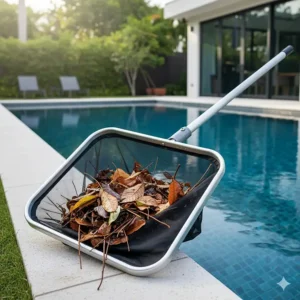
2. U.S. Pool Supply Professional Swimming Pool Leaf Skimmer Net
The U.S. Pool Supply Professional Swimming Pool Leaf Skimmer Net brings solid performance without breaking the bank. This 5-foot complete kit includes a 4-section aluminum pole that extends your reach significantly, making it ideal for larger pools or those hard-to-access corners.
Key Specifications:
- Total length: 60 inches (5 feet) with pole
- Net depth: 6 inches with ultra-fine mesh
- Material: Lightweight aluminum sections with clip connections
- Compatible with: Pools, spas, ponds, and kiddie pools
Customers love how the sections click together securely, and the ultra-fine mesh captures everything from visible leaves to tiny particles. One reviewer mentioned it feels “a bit flimsy but hasn’t let me down yet,” which honestly describes most mid-range pool equipment. The net allows water to flow through easily while trapping debris effectively.
Pros:
✅ Complete kit with pole included
✅ Ultra-fine mesh catches small debris
✅ Multiple size options available
Cons:
❌ Pole sections could be sturdier
❌ Net depth may require frequent emptying
Price range: $20-30 on Amazon for the 5-foot standard model.
3. POOLWHALE Professional Pool Skimmer Net
For budget-conscious pool owners who refuse to compromise on quality, the POOLWHALE Professional Pool Skimmer Net hits that sweet spot perfectly. This 17-inch wide rake features a remarkably deep 14-inch net bag, meaning fewer trips to empty debris.
Key Specifications:
- Net dimensions: 17″W x 11″H x 14″D
- Frame construction: Aluminum core with protective plastic coating
- Handle compatibility: Fits standard 1.25″ telescopic poles
- Special feature: Weighted plastic tab for easier dumping
The heavy-duty nylon mesh resists tearing better than cheaper alternatives, and the rounded borders protect your pool liner from accidental scratches. Several customers specifically praise how the weighted bottom tab makes it easier to pour out collected debris without making a mess. Since 1998, the company has been delivering pool solutions, and their experience shows in the thoughtful design details.
Pros:
✅ Large capacity reduces emptying frequency
✅ Protective plastic coating on frame
✅ Excellent value under $25
Cons:
❌ Pole not included
❌ Medium mesh may miss finest particles
Price range: $20-25 on Amazon.
4. The Skimmie Mr. Frog Pool Skimmer Net
Created by the inventors of The Skimmie pole system, the Mr. Frog Pool Skimmer Net specializes in handling both small specs and surprisingly large objects. This 20-inch wide beast can retrieve pool toys, small animals, and substantial tree debris that would overwhelm standard nets.
Key Specifications:
- Net width: 20 inches with angled sidewalls
- Material: Premium ABS plastic frame
- Design feature: Double-reinforced bridge frame
- Heat resistance: Withstands harsh pool chemicals and UV exposure
What sets Mr. Frog apart is the drag bag design that prevents tears during heavy use, plus the angled sidewalls that make scooping debris almost effortless. Customer reviews consistently mention how this net “accommodates all the subtle features that usually lack from skimmer nets.” The ABS plastic construction handles Arizona heat and chlorine without degrading.
Pros:
✅ Handles large and small debris equally well
✅ Double-reinforced frame for extra durability
✅ Drag bag prevents tearing
Cons:
❌ Wider profile may be awkward in tight spaces
❌ Higher price point for plastic construction
Price range: $30-40 on Amazon.
5. Mowend Swimming Pool Skimmer Net
The Mowend Swimming Pool Skimmer Net delivers impressive versatility with its 4-section telescopic aluminum pole that adjusts from compact to a full 57 inches. Perfect for hot tubs, spas, and smaller pools where maneuverability matters.
Key Specifications:
- Total extended length: 57 inches
- Pole sections: 4-piece telescopic aluminum
- Net type: Standard mesh with good water flow
- Weight: Lightweight for one-handed operation
This setup excels at fast cleaning without the bulk of professional-grade equipment. The telescopic design means you can adjust the length based on your task—shorter for precise work around spa jets, longer for reaching across the pool surface. Reviewers appreciate how lightweight it feels during extended cleaning sessions, though a few mention the aluminum could be slightly thicker for maximum durability.
Pros:
✅ Adjustable length for different tasks
✅ Complete kit ready to use
✅ Lightweight for easy handling
Cons:
❌ Aluminum pole thinner than premium models
❌ Standard mesh may require multiple passes
Price range: $25-35 on Amazon.
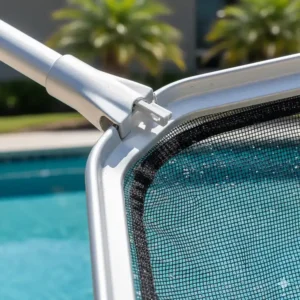
6. Sunnyglade Swimming Pool Leaf Rake
Don’t let the budget-friendly price fool you—the Sunnyglade Swimming Pool Leaf Rake punches well above its weight class. This entry-level option delivers surprisingly robust performance for casual pool owners and smaller setups.
Key Specifications:
- Net size: 18 inches with fine mesh
- Frame: Heavy-duty molded plastic
- Depth: Deep bag design for good capacity
- Color options: Blue standard
Customer reviews describe this as a “well-designed skimmer that’s perfect for quick daily cleanups.” The fine mesh captures leaves, bugs, and small particles effectively, while the smooth plastic frame won’t scratch vinyl liners. At under $20, it’s an excellent starter net or backup option for your primary skimmer. The build quality exceeds expectations for the price point, making it one of the best values in the category.
Pros:
✅ Outstanding value under $20
✅ Fine mesh for effective debris capture
✅ Safe for all pool surface types
Cons:
❌ Plastic frame less durable than aluminum
❌ Pole sold separately
Price range: $15-20 on Amazon.
7. Intex Deluxe Pool Cleaning Maintenance Kit
If you’re starting from scratch or want a complete solution, the Intex Deluxe Pool Cleaning Maintenance Kit provides everything you need in one box. This comprehensive set includes a deep skimmer net, scrub brush, vacuum attachment, and a sturdy telescopic pole extending up to 110 inches.
Key Specifications:
- Total pole length: 110 inches extended
- Kit includes: Skimmer net, brush, vacuum, pole
- Compatibility: Designed for above-ground, works with inground
- Brand heritage: From Intex, trusted pool equipment manufacturer
The pole stands out as exceptionally solid compared to typical budget kits—thicker, more comfortable to hold, and built to last. The plastic cleaning heads feel more substantial than cheaper alternatives, and the deep skimmer net is well-molded for scooping debris from both surface and floor. It’s basically a one-stop shop for pool maintenance essentials without buying accessories separately.
Pros:
✅ Complete maintenance solution
✅ Exceptional pole quality
✅ Versatile for multiple pool types
Cons:
❌ Larger investment upfront
❌ May include tools you don’t need
Price range: $30-45 on Amazon.
🎯 Ready to Transform Your Pool Maintenance Routine?
These carefully selected pool surface skimmer nets represent the best value, performance, and durability available in 2025. Click any product name above to check current Amazon pricing and customer reviews. Your crystal-clear pool is just one purchase away! 🏊♂️✨
Understanding Pool Surface Skimmer Net Basics
Before we dive deeper into selection criteria, let’s establish what makes a surface skimmer net different from other pool cleaning tools. A surface skimmer net (also called a leaf skimmer, pool net, or skimmer rake) consists of three main components: the frame, the mesh bag, and the handle attachment.
The frame provides structural integrity and determines the net’s overall size and shape. Most quality frames use aluminum for its lightweight yet durable properties, though premium ABS plastic has gained popularity for its resistance to pool chemicals. The frame shape matters too—flat nets work best for wall cleaning, while slightly angled designs excel at scooping from the bottom.
The mesh bag is where the magic happens. Mesh size significantly impacts performance, with ultra-fine meshes (around 400-700 microns) capturing tiny particles but potentially slowing down your skimming motion. Coarser meshes (800-1200 microns) allow faster water flow but might miss smaller debris. The bag depth also matters—shallow nets require frequent emptying, while deeper bags (12+ inches) handle more volume.
According to the Environmental Protection Agency, proper pool maintenance including regular surface skimming helps maintain water quality and reduces the need for excessive chemical treatments. This not only saves money but also creates a healthier swimming environment for your family.
How Pool Surface Skimmer Nets Improve Water Quality
You might think skimming is purely cosmetic, but it plays a crucial role in your pool’s overall health. When organic debris like leaves, grass, and insects float on the surface, they begin decomposing almost immediately. This decomposition process consumes chlorine, introduces bacteria, and creates nutrient-rich conditions for algae growth.
By removing surface debris promptly with a pool surface skimmer net, you prevent this cascade of problems before it starts. Your chlorine works more efficiently, your filter system faces less strain, and your water stays balanced with fewer chemical adjustments. Pool industry experts recommend skimming at least once daily during peak seasons—more frequently if your pool sits under trees.
The economic impact is real too. A study from the Centers for Disease Control and Prevention found that properly maintained pools require 25-30% less chemical treatment over a season compared to poorly maintained ones. That translates directly to savings on chlorine, shock treatments, and algaecides. Your pump also runs more efficiently when it’s not fighting against a clogged filter, reducing electricity costs.
Surface skimming also extends your filter’s lifespan. When debris bypasses your skimmer and enters the filtration system, it accelerates wear on filter media, pump impellers, and plumbing components. A quality net catches problems before they become expensive repairs, making it one of the best investments in preventive maintenance.
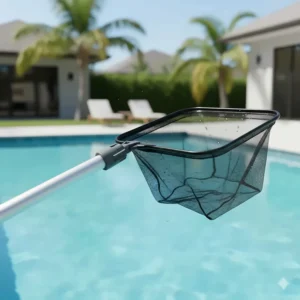
Mesh Types and Their Impact on Performance
The mesh in your pool surface skimmer net isn’t one-size-fits-all, and understanding the differences helps you choose the right tool for your situation. Ultra-fine mesh (400-600 microns) captures nearly everything, including pollen, fine silt, and tiny insects. However, this thoroughness comes with increased drag through water, making skimming physically demanding during extended sessions.
Fine mesh (600-800 microns) offers a better balance for most homeowners. It catches leaves, bugs, and moderate-sized particles while maintaining reasonable water flow. This category includes most “professional” nets marketed to pool service companies who need efficiency across multiple client pools daily.
Medium mesh (800-1200 microns) prioritizes speed over particle capture. These nets glide through water easily, making them ideal for quick surface passes or situations with primarily large debris like leaves and twigs. However, smaller particles slip through, requiring more frequent comprehensive cleanings.
Some manufacturers now offer dual-layer or graduated mesh designs. These clever constructions feature finer mesh at the bottom where debris settles and coarser mesh on the sides for water flow. It’s an interesting compromise that addresses both capture efficiency and ease of use, though these nets typically cost more.
Frame Materials: Aluminum vs. Plastic Considerations
The frame material debate in pool surface skimmer nets often comes down to aluminum versus high-grade plastic, each with distinct advantages. Aluminum frames dominate the professional market for good reason—they’re lightweight, don’t corrode in properly treated water, and maintain shape under load. Quality aluminum frames feature reinforced corners and powder-coated finishes that resist both chlorine and saltwater.
However, aluminum’s reputation isn’t spotless. Lower-quality aluminum can bend permanently under stress, especially at the connection points where the handle attaches. Thin aluminum frames might also develop stress fractures after repeated heavy use, particularly when scooping water-logged debris that exceeds recommended weight limits.
Enter premium ABS plastic, which has revolutionized pool equipment design. Modern ABS plastic resists UV degradation, handles temperature extremes, and won’t corrode under any conditions. The Mr. Frog net, for example, uses ABS plastic specifically because it withstands Arizona’s brutal heat and harsh chemical exposure better than metal alternatives. The material maintains flexibility without cracking, absorbing impacts that would dent aluminum.
The downside? Plastic frames generally weigh slightly more than comparable aluminum designs, though the difference rarely exceeds a few ounces. Some professionals also prefer aluminum’s rigid feel, finding plastic frames too flexible for aggressive bottom-raking. Ultimately, both materials perform excellently when properly engineered—cheap versions of either material will disappoint.
Deep Bag vs. Shallow Bag Design Trade-offs
Bag depth in your pool surface skimmer net dramatically affects user experience, yet it’s often overlooked during purchase decisions. Shallow bags (6-8 inches) excel at surface skimming where debris hasn’t settled. They’re lightweight when full, dump easily, and create minimal drag through water. Perfect for daily maintenance of relatively clean pools.
Deep bags (12-16 inches) target different needs entirely. These workhorses accommodate large volumes of leaves, handle bottom-raking without spilling debris back out, and reduce the emptying frequency that drives many people crazy during fall cleanup. The ProTuff model’s 14-inch depth, for instance, lets you cover more ground between dumps, making it efficient for commercial applications or heavily treed properties.
However, deep bags introduce complications. When full of water and debris, they become surprisingly heavy, requiring more strength for dumping. The increased surface area also creates noticeable drag during skimming, slowing your motion through the water. Some users find this exhausting during extended cleaning sessions, especially in larger pools.
A practical middle ground exists around 10-12 inches—deep enough for reasonable capacity, shallow enough for manageable handling. Consider your typical debris load when choosing. If you’re mainly fighting daily leaves and bugs, a shallower design suffices. Tackling post-storm cleanup or seasonal opening? Go deep and thank yourself later.
Handle Compatibility and Telescopic Pole Options
Your pool surface skimmer net is only as good as the pole you attach it to, yet this aspect often receives minimal attention until you’re frustrated by incompatibility issues. Most nets use a standard 1.25-inch diameter handle fitting, but quality matters enormously. Look for universal quick-connect designs with secure locking mechanisms—nothing kills motivation faster than a net that twists or pops off mid-skim.
Telescopic poles offer adjustability that fixed-length poles can’t match. Quality telescopic models feature internal locking collars that prevent unexpected collapse during use. The Mowend kit’s 4-section pole, for example, adjusts from compact for storage to 57 inches for extended reach, all while maintaining stability. Cheaper telescopic poles develop play at the connections after repeated adjustments, becoming progressively more frustrating.
Fixed-length poles still have their place, particularly in professional settings where durability trumps adjustability. An 8-foot aluminum pole with reinforced construction outlasts most telescopic alternatives when subjected to daily commercial use. The lack of joints eliminates potential failure points, and the rigid structure provides better control for aggressive bottom-raking.
Pole material matters too. Aluminum remains standard, but fiberglass poles have entered the market offering flexibility that prevents breakage during mishandling. Some professionals swear by fiberglass for its ability to bend rather than snap when caught on pool edges or stepped on accidentally. Weight-wise, modern materials make extended reach poles surprisingly manageable, even approaching 12-16 feet for commercial applications.
Maintenance Tips for Extending Skimmer Net Lifespan
Even the best pool surface skimmer net requires proper care to deliver years of service. After each use, thoroughly rinse your net with fresh water, paying special attention to the mesh where chlorine and debris accumulate. Residual pool chemicals accelerate material degradation, particularly in mesh fibers where concentration occurs during drying.
Store your net properly—avoid leaving it on hot concrete or in direct sunlight when not in use. UV exposure slowly breaks down both mesh and frame materials, causing premature brittleness and failure. Hanging your net in a shaded, ventilated area allows complete drying while protecting materials from environmental damage. Some pros use dedicated storage racks that support the frame without stressing the mesh attachment points.
Inspect your net regularly for developing issues. Small tears in mesh can be temporarily repaired with fishing line or nylon thread, extending usefulness until replacement becomes necessary. Check frame joints for loosening screws or developing cracks—catching these early often means a simple tightening rather than complete failure during use.
The handle attachment point deserves special attention. This high-stress connection point experiences repeated twisting and pulling forces that can loosen hardware or crack frames. Periodically check and tighten any adjustable components, and watch for signs of stress cracking around mounting points. Many quality nets feature replaceable handle assemblies specifically because this component wears before other parts.
Consider seasonal deep cleaning for nets used in heavy-debris conditions. Soaking in a dilute white vinegar solution (1 part vinegar to 10 parts water) helps dissolve mineral deposits and organic buildup without damaging materials. Follow with thorough rinsing and complete drying before storage. This extra step can significantly extend mesh life, particularly in hard-water areas where calcium accumulation becomes problematic.
Common Mistakes When Using Surface Skimmer Nets
Even experienced pool owners sometimes develop bad habits that reduce skimmer effectiveness and damage equipment. The biggest mistake? Scooping too aggressively. Ramming your net into debris or attempting to lift excessive weight stresses frame connections, bends aluminum, and tears mesh. Instead, use smooth, controlled motions that allow water to drain before lifting.
Many people also maintain excessive downward pressure while skimming, forcing the net deeper than necessary. This creates unnecessary drag, accelerates mesh wear from bottom contact, and makes the job exhausting. Your net should glide just below the surface, using gentle downward pressure only when targeting sunken debris.
Ignoring mesh maintenance is another common error. Accumulated debris in mesh pores reduces effectiveness, forces you to work harder, and promotes material breakdown. Take 30 seconds to thoroughly rinse your net after use—it’s the difference between equipment lasting one season versus five.
Improper emptying technique damages both nets and pool surroundings. Sharply flicking or shaking your net to remove debris stresses the mesh-frame connection, often causing premature separation. Instead, turn the net upside down over your collection container and let gravity do the work, using gentle tapping if needed.
Finally, using the wrong net for the job causes frustration and equipment damage. Fine-mesh nets aren’t meant for bottom-raking in debris-heavy conditions—that’s a job for leaf rakes with coarser mesh. Similarly, using a surface skimmer to remove settled, water-logged leaves from the deep end exceeds design limits and leads to failure.
Seasonal Considerations for Different Climates
Your pool surface skimmer net needs vary dramatically with seasons and climate. In spring, pollen season demands ultra-fine mesh capable of capturing tiny yellow particles that turn water cloudy. This is when those premium fine-mesh nets justify their higher cost, potentially saving hours of filter cleaning and chemical rebalancing.
Summer brings insects—lots of them. Bees, wasps, beetles, and various flying bugs meet their demise in pools nationwide. A good standard-mesh net handles these easily, and you’ll want to skim at least daily (morning works best) to prevent decomposing insects from consuming chlorine and creating bacterial growth.
Fall presents the biggest challenge for most pool owners. Leaf accumulation can overwhelm inadequate equipment, turning maintenance from a quick daily task into an exhausting marathon. This is when deep-bag designs and large-capacity nets become essential. Consider having both a fine-mesh net for regular maintenance and a larger leaf rake specifically for fall cleanup.
Winter maintenance depends on your location. In regions where pools stay open year-round, skimming frequency can decrease but shouldn’t stop entirely. Reduced usage means less debris overall, but wind-blown materials still accumulate. Cold-climate areas with covered pools need different approaches—removing snow and debris from pool covers with specialized tools prevents damage and spring cleanup nightmares.
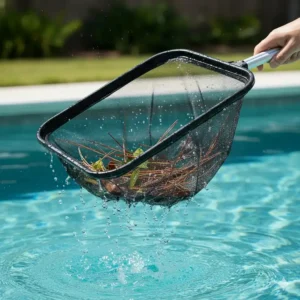
Environmental Impact and Sustainable Choices
The pool maintenance industry is gradually embracing sustainability, and your choice of pool surface skimmer net reflects this trend. Quality, durable nets that last multiple seasons create less landfill waste than disposable-quality options requiring annual replacement. Companies like ProTuff, with their lifetime replacement warranty, exemplify this approach—you keep the same frame and pole while replacing only worn mesh.
Look for manufacturers using recycled materials in construction. Some aluminum frames now incorporate significant post-consumer content, and certain plastic frames use ocean-recovered plastics. These products perform identically to virgin-material versions while reducing environmental impact. The packaging itself tells a story—minimal, recyclable materials indicate a company’s environmental consciousness.
Proper debris disposal matters too. Composting leaves and organic matter removed from your pool creates nutrient-rich soil amendment for gardens rather than sending it to landfills. Avoid chemical-laden debris in compost piles, however—chlorine-saturated materials need separate disposal. Many municipalities now offer green waste collection that handles pool skimmings appropriately.
Energy efficiency connects indirectly to your skimmer net choice. By effectively removing surface debris before it enters your filtration system, you reduce pump run time, filter cleaning frequency, and chemical usage. These seemingly small savings accumulate significantly over a season, reducing both your environmental footprint and utility costs. It’s a compelling argument for investing in quality tools that encourage regular maintenance.
Professional vs. Homeowner-Grade Equipment Differences
Professional pool service technicians use equipment daily across multiple client pools, facing demands that would destroy homeowner-grade tools in weeks. Understanding these differences helps you decide whether premium equipment justifies the investment for residential use.
Professional nets prioritize durability and repairability. Modular designs allow quick part replacement in the field—a professional can’t lose half a day because a net broke. They feature reinforced stress points, commercial-grade materials, and often carry warranties specifically excluding residential applications because the usage patterns differ so dramatically.
Homeowner-grade equipment emphasizes convenience and price-performance balance. You’re skimming one pool, probably 3-4 times weekly at most, under far less demanding conditions. A quality homeowner net should last 3-5 years with proper care—longer than most people keep the same pool equipment anyway. Spending professional-level money often provides minimal additional benefit for residential applications.
That said, homeowners with specific challenges might benefit from pro-grade gear. Heavy tree coverage, large pools, or physical limitations that make frequent emptying difficult can justify commercial equipment’s higher capacity and durability. Similarly, vacation rental properties with pools face usage patterns closer to commercial applications, making professional equipment a wise investment.
The sweet spot for most homeowners? Look for “prosumer” products—equipment designed to professional standards but priced for dedicated homeowners. These products often carry features like lifetime warranties, reinforced construction, and modular design without the commercial price premium. The U.S. Pool Supply and ProTuff lines exemplify this category perfectly.
Safety Considerations During Pool Maintenance
Pool maintenance seems straightforward, but injuries happen more often than people realize. When using your pool surface skimmer net, never reach or lean excessively—more than one person has tumbled into the pool while over-extending. If you can’t comfortably reach a debris pile, get a longer pole rather than risking a fall.
Wet pool decks become treacherously slippery, especially around pool edges where splashed water accumulates. Wear appropriate footwear with good traction, and keep your workspace clear of trip hazards like coiled poles and discarded debris piles. Consider placing a non-slip mat in your regular working area—a small investment that prevents potentially serious falls.
Chemical exposure deserves attention too. While your net doesn’t directly handle pool chemicals, it does contact chlorinated water that can irritate skin during extended exposure. Wearing nitrile gloves protects hands from both chemical irritation and cuts from sharp debris occasionally snagged in nets. The gloves also improve grip on wet pole handles.
Sun protection often gets overlooked during maintenance tasks. You’re typically working during peak UV hours, bent over in positions that expose the back of your neck and shoulders. Apply sunscreen before starting, wear a hat, and consider UV-protective clothing if you’ll be working extensively. Heat exhaustion and sunburn turn a simple maintenance task into a miserable experience.
Electrical safety cannot be ignored. If you’re using any powered equipment near the pool, ensure ground fault circuit interrupter (GFCI) protection on all outlets. Keep electrical devices and cords far from water, and never handle electrical equipment with wet hands. These basics prevent potentially fatal accidents during routine maintenance.
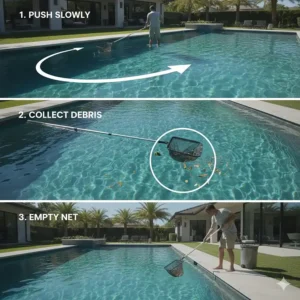
❓ Frequently Asked Questions
❓ How often should I use my pool surface skimmer net?
❓ Can I use a pool surface skimmer net in a saltwater pool?
❓ What mesh size works best for capturing pollen?
❓ How do I prevent my net from tearing?
❓ Should I buy a net with or without a pole?
Conclusion: Making Your Final Decision
Choosing the right pool surface skimmer net ultimately comes down to matching equipment to your specific situation. Consider your pool size, typical debris load, physical capabilities, and budget when evaluating options. A quality net is an investment that pays dividends through reduced maintenance time, lower chemical costs, and extended equipment lifespan.
For most homeowners, mid-range nets like the U.S. Pool Supply or POOLWHALE models offer exceptional value, delivering professional-level performance at consumer-friendly prices. Those with heavy debris loads or professional needs should seriously consider the ProTuff option—its lifetime warranty and superior durability make it a sound long-term investment despite higher upfront costs.
Budget-conscious buyers shouldn’t overlook the Sunnyglade option, which provides surprising quality at entry-level pricing. It’s perfect for smaller pools, occasional use, or as a backup to your primary skimmer. Conversely, complete kit solutions like the Intex Deluxe set appeal to new pool owners wanting a comprehensive maintenance package without piecing together individual components.
Remember that even the best net requires regular use to be effective. Establish a consistent skimming routine—morning works well for most people—and stick to it. Those few minutes daily prevent hours of intensive cleaning later and keep your pool looking pristine for spontaneous swimming opportunities. Your future self will thank you for the discipline.
🏊 Transform Your Pool Experience Today!
Stop wrestling with inferior equipment and start enjoying crystal-clear water effortlessly. Browse the complete selection of pool surface skimmer nets on Amazon today and find the perfect match for your needs. Every moment you delay means more debris, more chemicals, and more frustration. Click now and reclaim your weekends! 💧✨
Recommended for You
- Pool Corner Brush: 7 Best Options for Sparkling Clean Corners in 2025
- Pool Wall Brush for Vinyl Liner: 7 Best Picks 2025
- 7 Best Pumice Stone Holder for Pool Cleaning 2025
Disclaimer: This article contains affiliate links. If you purchase products through these links, we may earn a small commission at no additional cost to you.
✨ Found this helpful? Share it with your friends! 💬🤗

